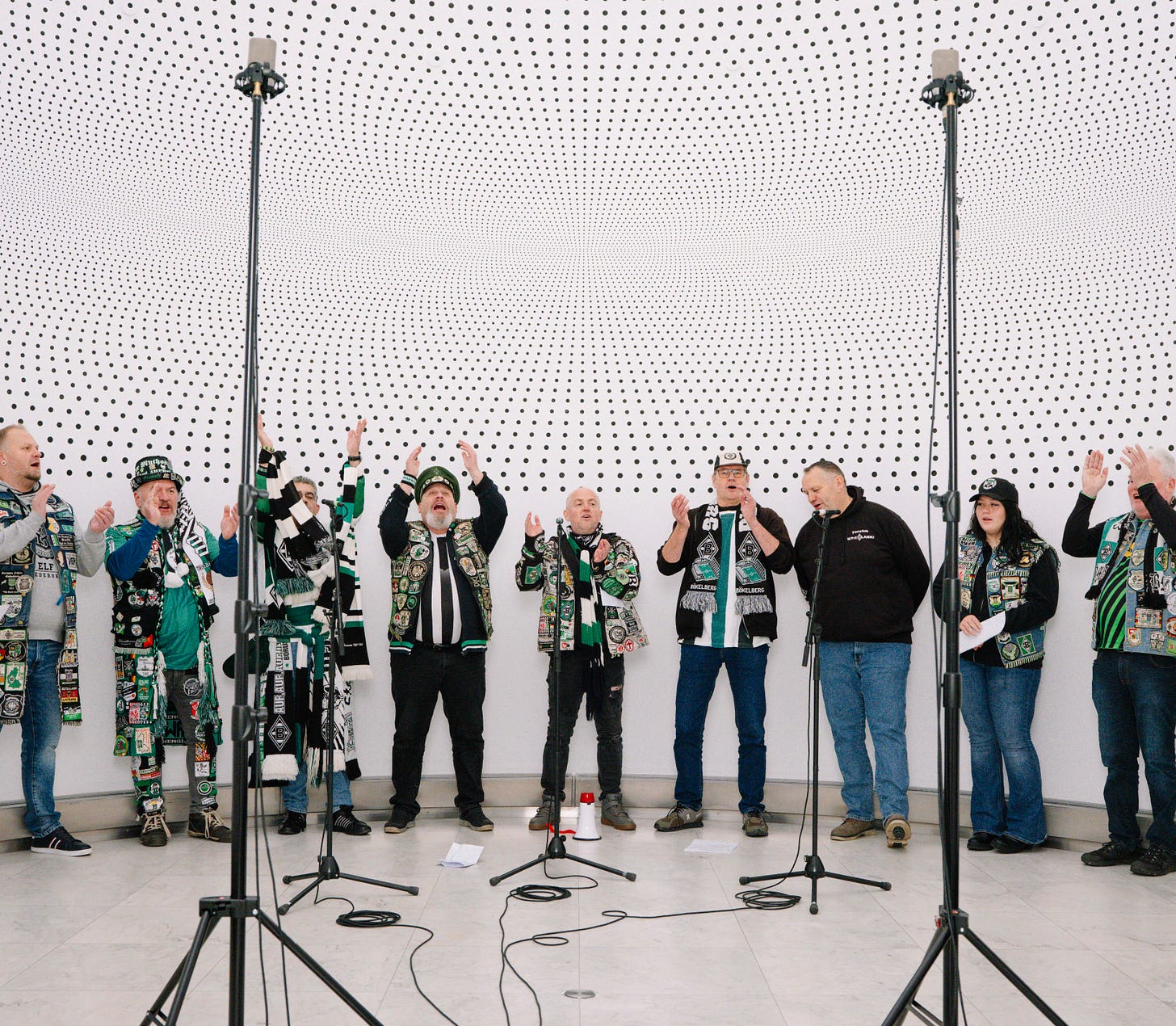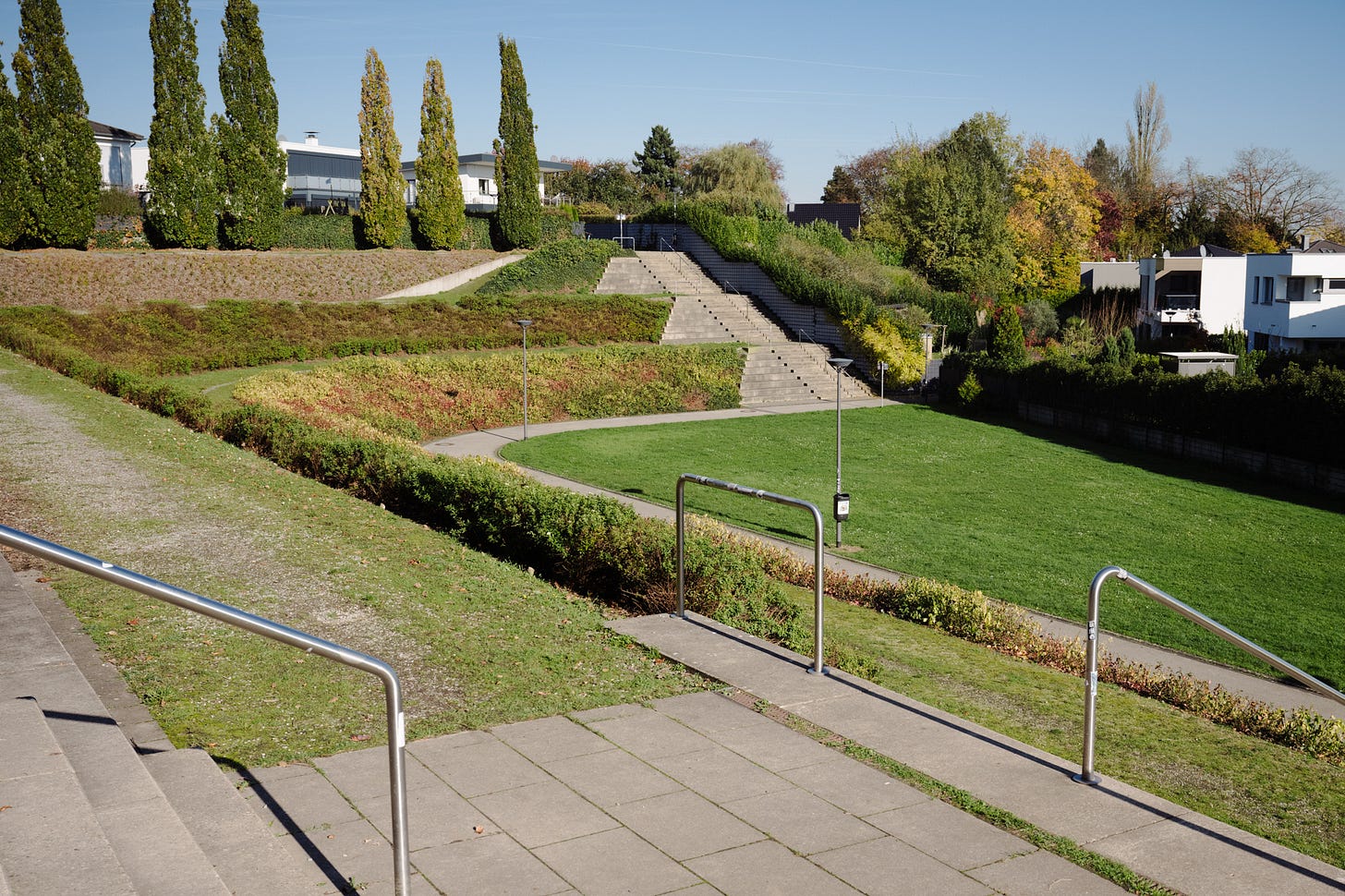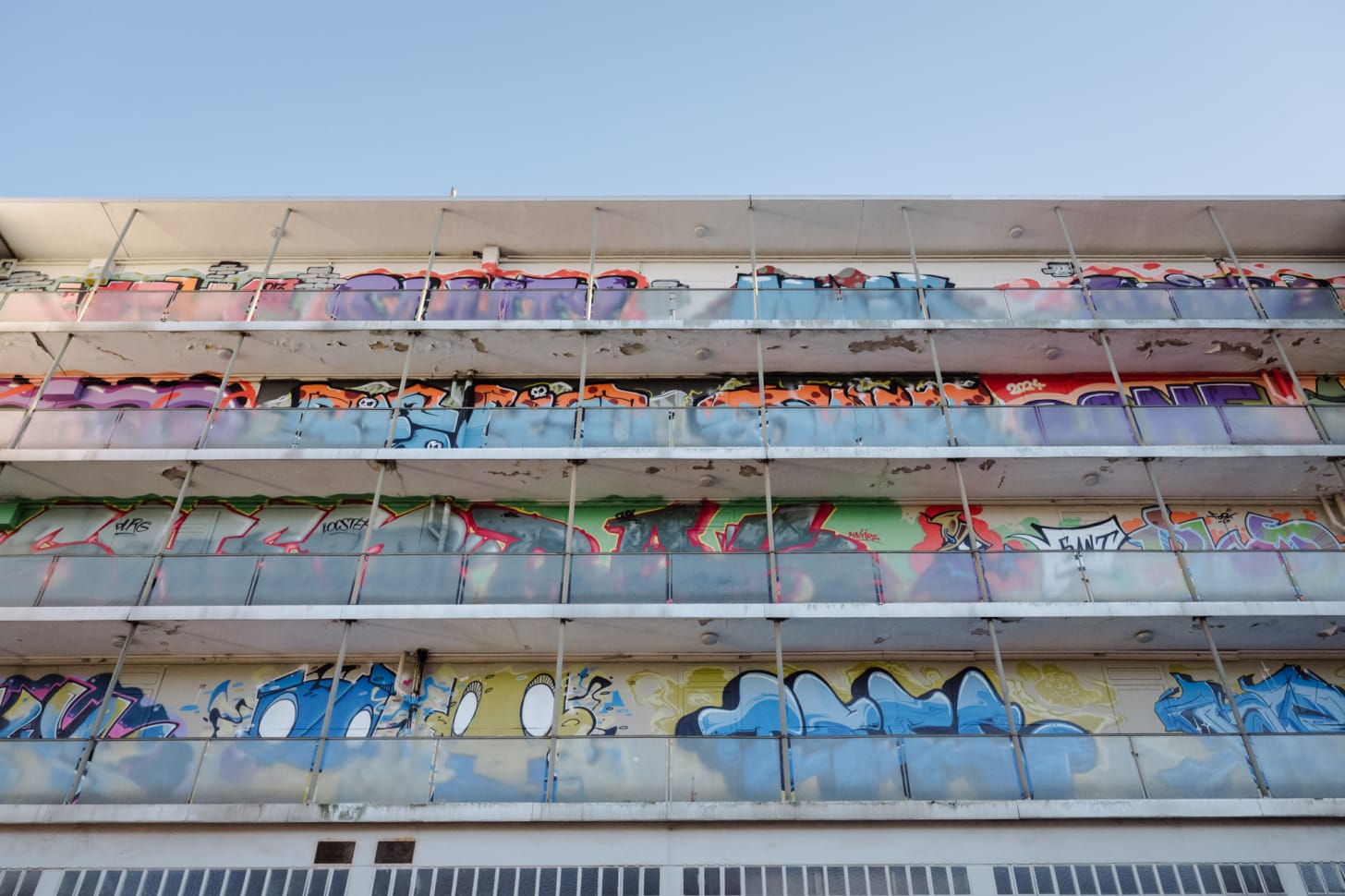The Sound of Soccer: Ari Benjamin Meyers Portrays Fan Club Culture at Museum Abteiberg
Allow me this pun: What was the goal?
A Man of the People…
I got invited to my first press tour ever in January: Museum Abteiberg in Mönchengladbach presents Ari Benjamin Meyers (Gen X, US-American) with the final act of his three-part project Kunsthalle for Music. Ari’s artistic focus is music, and for this show, he examined the music of an unlikely culture: Soccer fan clubs and their stadium chants.
On our tour, Museum Abteiberg director Susanne Titz (Baby Boomer, German) shared how Mönchengladbach lacks common ground. Many smaller villages were incorporated into the city over the years, making it a place where nobody was actually from. That’s what made Ari look for uniting factors. One of them being soccer.
It’s a genuinely intriguing phenomenon: In huge stadiums filled with thousands of people observing the match and experiencing angst, passion, and rage, songs find their way through the shouting crowd. Although soccer fan culture appears chaotic for a bystander like myself, Ari rightfully points out the choreographed and structured nature of fan chants. And yet, if I were to treat his project like an academic dissertation, I’d find that he asks good questions in the introduction. But arriving at the conclusion, he hasn’t answered them.

Conceiving the Fan Chant
For the last two years, Ari had been reaching out to fan clubs in Mönchengladbach. Some were open to collaborating, others declined. Finally, he brought together a sizeable community connected to the Borussia Mönchengladbach soccer club.
Ari asked the participants to share places in the city they consider important. He then filmed them at seven selected venues performing their favorite fan chant. For the exhibition duration, those venues display QR codes with the songs. In collaboration with the participants, Ari also composed a new fan chant, Die MG Elf [The MG Eleven], inviting everyone to sing it at the stadium during a game. The chant consists of eleven notes corresponding to eleven soccer players, simultaneously alluding to music theory’s Twelve-tone technique.
The exhibition features the results. A short film in the first room follows all seven venues with the participants performing the chants. The film doesn’t provide any clues as to where they are. You either recognize them because you’re from Mönchengladbach or came to the press tour. If neither applies, the exhibition booklet helps.

One venue that stuck to me was Bökelberg, the former Borussia stadium. We visited it on the press tour. A quarter of the Bökelberg remains recognizable as such. Some barriers were kept and greenery took over the former benches. The larger part of the area was developed for upscale residential housing. Walking through this boujee neighborhood comprised of large single-family houses with bulky Mercedes cars in the driveway, I was surprised to learn that many Ultras live there. The soccer rebels outgrew their rugged youth, made money, and settled down, but still identify as Ultras. I was disappointed that the tensions of class advancement and inherently classless soccer fan culture weren’t further elaborated on within the show.
I found that out through conversation, not the exhibition. And that’s the problem. Surely, the exhibition booklets might provide more background info to those who weren’t part of the curated press tour. But shouldn’t the core of the work and the key to understanding it lie in the work itself?
Whose Culture?
The second room displayed some hanging banners with stadium snapshots and seven light boxes corresponding to the seven venues. Each lightbox contained one photograph from the chant performance. You can put on headphones and listen to the corresponding chant recorded there. On top of each image, there’s poems by Evan Hugo Tepest (Millennial, German) written in a white dotted typeface. I’ll get to that in a second.
The execution slightly irritated me. Why lightboxes? Why poems? And why are they written in such a poorly decipherable dotted way? Like sure, there are lightboxes for advertisement at soccer stadiums. So? That isn’t a factor explored elsewhere in the show. One piece made me think of Jeff Wall’s (Baby Boomer, Canadian) iconic lightboxes: It featured fan club women in a desacralized church housing the ashes of Borussia fans (like gahdamn, those are real ride or dies). The women look motionless and frozen, staged the way Jeff would do it. Why make that connection?
Staying with those women, I feel like Ari doesn’t dive deeper into male homosociality within soccer fan clubs. Ari scratches the surface when dedicating one lightbox to women. The way he presents them in the former church appears to me as a very patriarchal gaze: Iconographically, it’s widows mourning their husbands in the safe realm of religious devotion. Might Ari’s perspective be critical of such a gaze?
The poems help argue in his favor. Evan’s lines play with intimacy. As I read in his corresponding essay, he partly integrated phrases said by the participants. The recurring 1:1 as a game score could allude to a one-on-one conversation. The speaker comes to the addressee at the eleventh hour, comforts them: You are my dream team. An ambiguous one: Were you at the men’s restroom? Ari might make space for a conversation on queerness which the culture doesn’t offer. Or is that a prejudice I hold once again as a bystander?
When I think of soccer fan culture, I think of pyrotechnics and drunk men starting fights. Violence is a part of Ari’s investigation. One venue is the now abandoned old police headquarters. Co-curator Gian Marco Hölk (Millennial, German) told me that during some matches, the jail cells used to be overburdened with incalculable fans. That’s one side. But the other is love, family, and belonging, as the fans explain in Ari’s film.

And yet, some questions remain unanswered. Returning to the choreographed nature of soccer chants I mentioned initially: that doesn’t get explored. Only in one instance in the film, you can see individuals in the stadium coordinating the chanting. But that’s already it. Class isn’t explored. Conflicts between rival clubs and their fans aren’t explored.
What is the artwork in the project? Is it the show or the friends we made along the way? Would it be appropriate to call Ari’s project community art? Who is it really for at the end of the day? His approach could have been applied to any soccer club anywhere. Of course, the same questions result in different answers depending on who you ask. But Ari stays within the framework. I would have loved to see the unexpected paths the project could have taken if let outside the box.
Ari Benjamin Meyers: Hymnus (Fankurve), through February 23, 2025, at Museum Abteiberg, Mönchengladbach.
Museum Abteiberg
Abteistraße 27 / Johannes-Cladders-Platz
41061 Mönchengladbach
Website
Instagram: @museumabteiberg @kunsthalleformusic
Thank you for reading! If you enjoy my reviews, consider becoming a free or paid subscriber. And feel free to leave a like or a comment. Or both.
See you soon!!!
Jennifer
The Gen Z Art Critic





